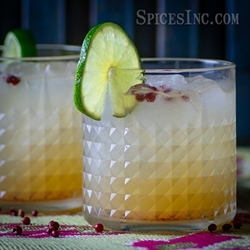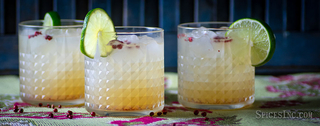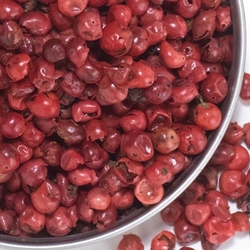Pink Peppercorn Gimlet

Gimlets have a murky history, confounded by alcohol and legend. What seems fairly certain is that the gimlet was created as a means to entice British naval officers in the 19th century to drink lime juice, rich in Vitamin C, to combat scurvy, in the same way gin and tonic was created so British army officers could combat malaria. Some sources claim this cocktail was so named in honor of Rear-Admiral Sir Thomas Desmond Gimlette, the naval doctor who thought to mix the gin with lime juice “to help the medicine go down”. Other sources believe it was called the gimlet in honor of the tool, also called a gimlet, that was used on ships to bore holes into barrels of liquor. The cocktail, it was said, mimicked the piercing qualities of the tool. Neither claim is entirely supportable, but both are believable. Decide which you like best and run with it.
Originally half gin, half lime cordial, this cocktail has often been described as forgiving, impossible to mess up, and wide open to interpretation. You can use vodka instead of gin. Serve it on the rocks, or up in an ice-cold martini glass. You can play with flavored liqueurs, adding a little bit of elderflower or bergamot, or try a gimlet topped with a dash of exotic bitters. Change the ratio of spirits to mixer; consumer palates have changed since this drink was created in favor of less sweet drinks, and most gimlets are a 2:1 or 3:1 ratio now. Or you can get creative with your spice cabinet, and add an unusual ingredient to the shaker. We recommend Pink Peppercorns.
Pink Peppercorns are endearingly misnamed. Although they are roughly the size and shape of a conventional peppercorn, they are not related to Black Pepper at all. They are, rather, members of the cashew family, a berry that can be found on a tree that grows in Brazil. They are citrusy-sweet and vaguely nutty, with a chirpy bit of playful spice. We muddled these into the bottom of a cocktail shaker and topped them with a lime-forward botanical gin, to pick up the citrus notes of the Pink Peppercorns. If you have the time, allow the gin and the peppercorns a few minutes to mingle in the cocktail shaker, before adding the remaining ingredients and shaking. We let ours sit for about ten minutes.
Right before you finish mixing the drink, decide what kind of glass you want to use. If you’re using a rocks glass, fill it with ice and let it sit. If you’re using a martini glass, put ice and water in the glass, and let the glass get nice and cold. Then add the lime juice and honey simple syrup to the gin and Pink Peppercorns, top with ice, put the lid on the cocktail shaker and start chilling the drink, shaking vigorously until the frost starts to climb up the side of the shaker.
Remove the lid and, if possible, use a Hawthorne strainer for your cocktail—the sort of bar strainer that has a springy wire around the top end. The Pink Peppercorns easily clog the straining holes in a standard shaker lid, but the Hawthorne strainer holds them back for a clog-free pour. Pour this right over the ice in your rocks glass, or discard the ice water and pour it straight into the chilled martini glass. Garnish with some lime wheels and a few cracked Pink Peppercorns, and enjoy this brisk, refreshing cocktail. And get a dose of Vitamin C, while you’re at it.
- 1 1/2 teaspoons whole Pink Peppercorns
- 2 ounces botanical gin, preferably lime-forward
- 1 ounce lime juice, freshly squeezed
- 1/2 ounce honey simple syrup*
- Garnish with a lime wheel and whole pink peppercorns
1. Put pink peppercorns in a cocktail shaker. Muddle to crack the peppercorns, then pour in gin. Add lime juice and honey simple syrup, and ice. Shake until the frost starts to climb the sides of the shaker.
2. Strain gimlet into your preferred glass. It can be served up in a martini glass or over ice in a rocks glass.
3. Garnish with a lime wheel and some uncracked pink peppercorns.
*To make honey simple syrup, mix equal amounts of honey and water together. This can be made in very small amounts; if you make more than you need at one time, store the remainder in the refrigerator for up to one month. If you’re making large batches of this, use a lightly flavored, all-purpose honey like clover or wildflower. Honeys with bold flavors, like chestnut or buckwheat, can compete with the other ingredients in a cocktail too much to be universally used.


